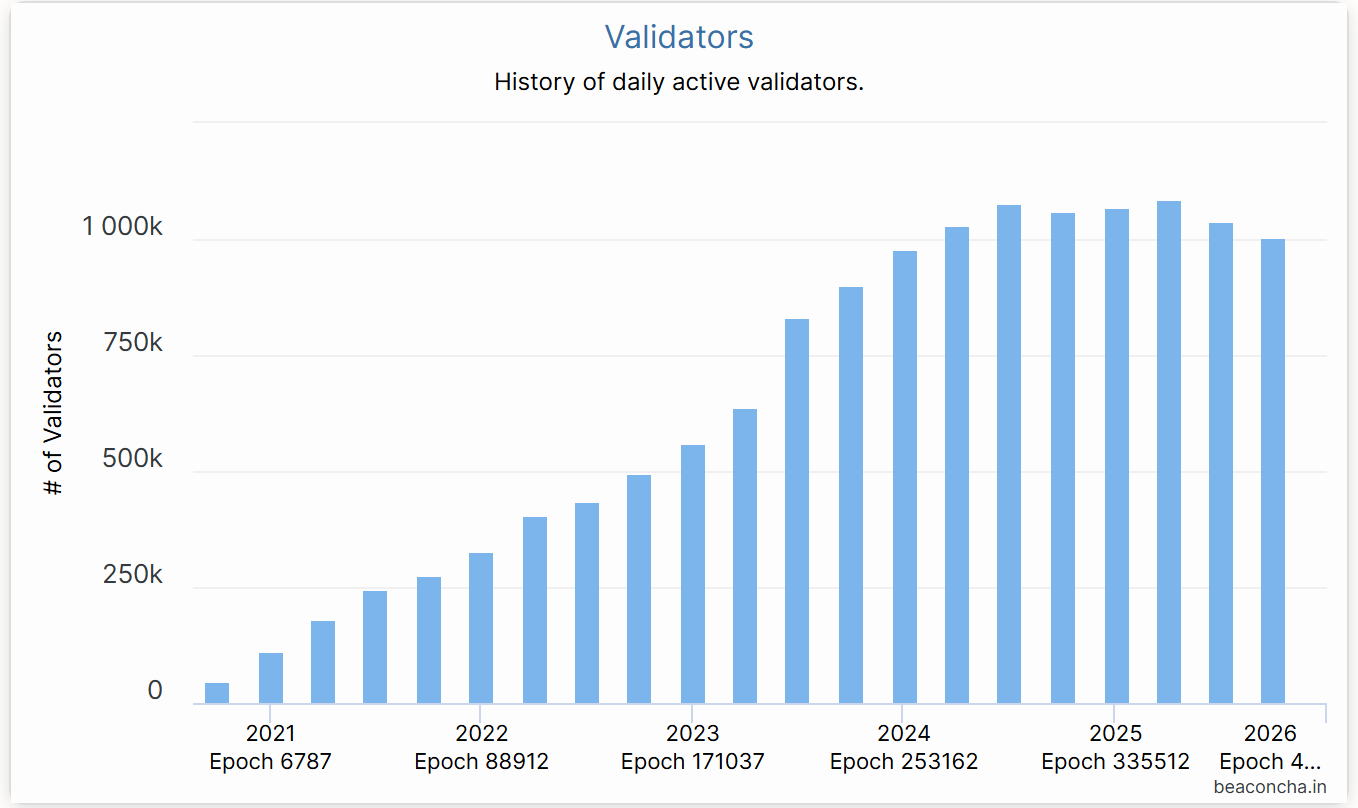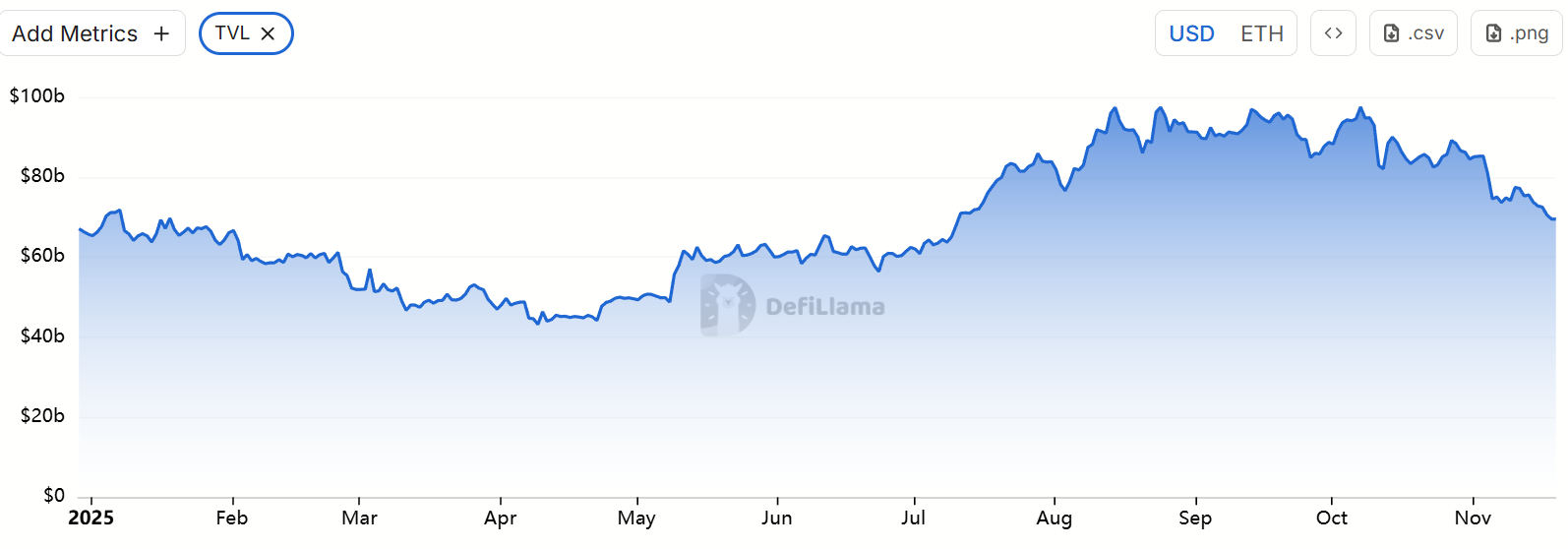I. Introduction
This week, developers from around the world are gathering in Buenos Aires for the annual Ethereum Developers Conference. Furthermore, Ethereum is set to receive a major upgrade in December, codenamed "Fusaka," which will increase data throughput by eight times, enhance network security, and introduce new development tools. Meanwhile, increased institutional participation is bringing strong capital inflows, and the RWA market is expected to provide a new growth engine for Ethereum.
However, due to macroeconomic uncertainties, Ethereum's price began to fall from its new high of $4,900 in early October, entering a downward trend. Especially after the "October 11th crash" black swan event, ETH's price has been sluggish, recently hovering around $3,000, a drop of over 30% from its peak. Funds that previously supported ETH's rise are now withdrawing: Ethereum Treasury (DAT) stock has plummeted, with holders turning from profit to loss, and some shareholders selling to cash out; multiple global ETH spot ETFs have experienced continuous net outflows, and traditional institutional investors are increasingly adopting a wait-and-see attitude. Meanwhile, the Ethereum ecosystem is frequently encountering setbacks: total locked value has decreased by over 20% since October, on-chain stablecoins have repeatedly failed and de-pegged, and DeFi protocols have suffered repeated setbacks.
This article will review Ethereum's recent performance, deeply analyze the positive and negative factors currently facing Ethereum, and look ahead to Ethereum's prospects and trends at the end of this year, next year, and even in the medium to long term. It aims to provide some reference for ordinary investors to clarify the confusion, grasp the trend, and make more rational judgments during key turning points.
II. Analysis of Ethereum's Recent Performance
In the third quarter of this year, the price of Ethereum climbed steadily along with rising market sentiment, surging from around $2,500 at the end of June to a peak of nearly $4,950 in late August. However, in October, a combination of macroeconomic and inherent market risks triggered an "epic crash." On October 11, the unexpected announcement by the US of additional tariffs on Chinese goods became the catalyst, triggering a global sell-off of risk assets, with the crypto market experiencing a sharp decline. The price of Ethereum once plummeted by more than 20% to a low of around $3,380. Although the market subsequently rebounded, liquidity gradually disappeared, and the overall trend remained downward. As of now, ETH is priced at around $3,000, a cumulative drop of more than 30% from its August high.

Source: https://www.tradingview.com/symbols/ETHUSD
1. Tightening Macroeconomic Environment: The tightening of macro liquidity and a hawkish shift in interest rate expectations are undeniable factors behind this round of adjustments. The Federal Reserve released a hawkish signal in November, cooling market expectations for a December rate cut and significantly reducing risk appetite. The crypto market's boom in the third quarter largely benefited from institutional funds "speculating on new offerings"—multiple Ethereum spot ETFs were launched in the summer, traditional investors rushed in, and several listed companies announced massive cryptocurrency purchase plans, creating strong buying support. However, entering October, increased uncertainty in the macroeconomic environment led to safe-haven funds flowing back to the US dollar and US Treasury bonds, rapidly depleting the marginal growth potential of the crypto market.
2. ETF Fund Outflows: According to SoSoValue data, in mid-November, the total holdings of Ethereum spot ETFs were approximately 6.34 million Ethereum (US$192.8 trillion), accounting for 5.19% of the ETH supply. However, this month saw a shift from net inflows to net outflows, with the scale of withdrawals significantly exceeding new inflows, and the largest single-day outflow reaching US$180 million. This contrasts sharply with the steady daily inflows into ETFs in July and August. ETF investors are mostly long-term investors, and the continuous net redemptions for several days indicate a weakening of demand for ETH from traditional financial channels. Their withdrawal not only directly reduces buying pressure but may also amplify short-term volatility.

Source: https://sosovalue.com/assets/etf/us-eth-spot
3. DAT Company Growth Slows: Divergence Emerges Within the Sector. As of mid-November, DAT's total Ethereum strategic reserves amounted to approximately 6.24 million ETH, representing 5.15% of the supply, with the pace of acquisition slowing significantly in recent months. Among the major players, early adopter BitMine is almost the only one still aggressively buying ETH: it added another 67,000 ETH in just the past week. Another leading company, SharpLink, has ceased its buying activity since purchasing 19,300 ETH in mid-October, with its holding cost at approximately $3,609, resulting in a paper loss. Furthermore, smaller treasury companies are forced to cut their losses: for example, ETHZilla sold approximately 40,000 ETH at the end of October to repurchase its own shares, hoping to narrow the share price discount. The treasury industry has shifted from a period of uniform expansion to one of polarization: powerful giants are still managing to maintain buying pressure, while smaller players are facing liquidity constraints and debt repayment pressures, forcing them to reduce their holdings and cut losses.


Source: https://www.strategicethreserve.xyz/
4. Leverage Clearing and Selling Pressure Emerge: In the secondary market, the rapid withdrawal of leveraged funds further exacerbated the selling pressure on ETH. During the October crash, large whale like " Machi Big Brother," who long continuously long, faced forced liquidation of their positions, triggering widespread market panic and undermining bullish confidence to some extent. According to Coinglass statistics, ETH contract open interest has plummeted by nearly 50% since its August high, indicating that leveraged funds are rapidly deleveraging. This signifies a cooling of both market speculation and liquidity. Not only are leveraged long positions retreating, but large holders who have been accumulating coins for a long time are also beginning to loosen their positions. On-chain analytics firm Glassnode reported that long-term holders who have held coins for more than 155 days are currently selling approximately 45,000 ETH (about $140 million) per day, the highest selling level since 2021, indicating that some long-term holders are choosing to cash out at higher levels. These signs indicate that the bullish forces within the market have significantly weakened.
5. Ethereum Staking Decline: Beacon Chain data shows that the number of active Ethereum validators has decreased by approximately 10% since July, marking the first significant drop in validator numbers since the transition to Proof-of-Stake (PoS) in 2022. The main reasons are: firstly, the surge in ETH prices in the first half of the year led many node operators to exit staking at high levels to realize their profits, resulting in a sharp increase in validator exit queues in late July, with a record high in daily ETH withdrawals; secondly, the recent drop in annualized staking yield to approximately 2.9%, coupled with rising on-chain lending rates, has squeezed arbitrage opportunities, weakening the price support of staking for ETH.

Source: https://beaconcha.in/
6. Stablecoin and DeFi Turmoil: Problems within the Ethereum ecosystem were also exposed, further damaging investor confidence. On October 11th, the day of the crash, USDe collapsed due to the failure of its revolving lending arbitrage mechanism, falling to as low as $0.65. Although it quickly recovered to near $1, it triggered a chain reaction. Subsequently, several risk events occurred in the decentralized stablecoin sector: xUSD, issued by the Stream protocol, first suffered severe de-pegging due to the collapse of its underlying hedge fund; subsequently, USDX, belonging to the same strategy, also fell to $0.38 when liquidity was critical, posing a risk of being unable to redeem at a 1:1 ratio; another algorithmic stablecoin, deUSD, also failed to escape unscathed, falling below its peg price. These once-promising new stablecoins failed under extreme market conditions, exposing the fragility and black-box risks of the "delta-neutral" stablecoin model under extreme market conditions. The successive failures of stablecoins dealt a heavy blow to DeFi. Starting in mid-October, several lending and yield aggregation protocols reported bad debts and a sharp drop in TVL (Total Value Limit): Morpho 's USDC vault was forced to delist related strategies due to the zero value of its associated Elixir stablecoin pool, resulting in a loss of approximately 3.6% of the vault's assets; the established lending protocol Compound also faced bad debt pressure due to the collapse in the value of some long-tail stablecoins, triggering a liquidation crisis. The Balancer protocol suffered a hacker attack at the end of October, resulting in losses exceeding $100 million. These events triggered a continuous outflow of DeFi funds. As of early November, Ethereum's on-chain TVL had fallen from its year-to-date high of $97.5 billion to approximately $69.5 billion, evaporating over $30 billion in assets in just over a month.

Source: https://defillama.com/chain/
Overall, Ethereum has faced a double whammy from the outside in over the past two months: a tightening external macro environment, simultaneous pressure on the three major buying forces (ETFs, treasuries, and on-chain funds), and internal turmoil in its stablecoin and security ecosystem. Amidst the doubts, both Ethereum's price and market capitalization have come under pressure.
III. Negative Factors: Macroeconomic Gloom and Potential Concerns
Undeniably, the current negative outlook surrounding Ethereum may continue to put pressure on ETH prices and ecosystem development in the short to medium term.
1. Macroeconomic tightening and capital withdrawal
The biggest headwind at present comes from the macroeconomic environment. Major central banks worldwide are maintaining cautious interest rate policies amidst unstable inflation, dampening expectations of a December rate cut and fueling strong risk aversion in the market. The forces that drove ETH's rise in the first half of the year (ETF subscriptions, DAT purchases, and on-chain leveraged accrual) have now become potential sources of selling pressure. If the macroeconomic environment remains weak over the next six months, it's possible that more institutions will indirectly reduce their ETH positions by redeeming ETFs or selling treasury company shares, leading to a continuous outflow of funds. In particular, the treasury model itself has certain vulnerabilities: companies like BitMine are currently trading at a significant discount, and shareholder confidence is low. If their financing chains break down or they face repayment pressure, the risk of being forced to sell ETH to realize cash cannot be ignored. In short, until global liquidity reaches a turning point, headwinds in funding are likely to continue to weigh on Ethereum.
2. Competition and Diversion Effect
Other public chains such as Solana and BSC have diverted speculative funds to some extent. Furthermore, the rise of cross-chain protocols and application chains like Plasma , Stable , and Arc has weakened Ethereum's appeal to projects and users. With the rise of modular blockchain concepts, some projects have even built their own sovereign rollups, no longer relying on Ethereum's security. Within the Layer 2 space, competition exists among numerous rollups: Arbitrum and Optimism are offering high incentives or airdrops to attract users and traffic, potentially leading to an "L2 war." The success of L2 does not directly equate to a rise in the price of the main chain ETH; instead, it may dilute some value. For example, some L2 platforms have issued independent tokens for fee payments, which could impact the long-term demand for ETH as a gas. Of course, ETH remains the primary settlement asset, so the short-term competitive impact is limited, but the long-term implications warrant caution.
3. Regulatory and policy uncertainties
The regulatory environment is also a Damocles' sword hanging over Ethereum's head. Although SEC Chairman Paul Atkins has stated that Ethereum should not be considered a security, a change in regulatory attitude could cast doubt on Ethereum's compliance status, thus impacting institutional participation. Furthermore, regulatory discussions on DeFi are underway in various countries, and decentralized stablecoins and anonymous trading may face stricter restrictions or even suppression. These policy uncertainties could hinder the development of the Ethereum ecosystem. For example, if some countries prohibit banks from participating in staking or restrict retail investors from buying and selling crypto assets, it will directly reduce potential capital inflows. Additionally, Europe's MiCA regulations, which impose requirements on stablecoin issuance and DeFi services, may increase the compliance costs for Ethereum projects.
4. Internal Ecosystem Risks and Trust Rebuilding
Following this series of events, the trust deficit in the Ethereum ecosystem will require time to heal. On one hand, the wave of stablecoin de-pegging has made DeFi users wary of high-yield products. Currently, the overall market risk appetite is lower, conservative strategies are prevalent, and users prefer centralized platforms or mainstream stablecoins like USDT/USDC. This will likely lead to liquidity shortages and limited growth for many innovative Ethereum protocols in the near future. On the other hand, frequent security incidents (such as hacking and vulnerabilities) have also raised questions about the security of Ethereum's application layer. Each major attack or crash is often accompanied by users of the relevant protocols selling ETH or withdrawing funds. It is expected that risk governance will become a key focus for the Ethereum community in the near future, and project teams may strengthen reserves and insurance measures to restore user trust. However, once the bear market mentality takes hold, investors often need more positive stimuli (such as price bottoming out and rebound, or the emergence of new applications) before they are willing to reinvest.
In short, Ethereum is currently in a bottoming-out phase, facing challenges both internally and externally. The retreat of macro-level funding, industry competition and regulatory pressure, as well as issues within its own ecosystem, are all likely to continue to suppress ETH's performance in the short term. These unfavorable conditions require time and sufficient positive stimulus to resolve. During this process, the market may experience further pain and fluctuations.
IV. Positive Factors: Upgrade-Driven and Fundamental Support
Despite recent turmoil, Ethereum remains a solid foundation as the largest public blockchain ecosystem, demonstrating resilience in the long run through its network effects, technological foundation, and value consensus.
1. Network effects and ecological resilience
- Development and innovation are thriving: Ethereum continues to lead the industry in both the number of active developers and projects, with a large number of new applications and standards emerging. During the DevConnect conference, several important developments garnered community attention: Vitalik reiterated Ethereum's principles of "trust neutrality and self-custody"; and cutting-edge topics such as account abstraction and privacy protection became focal points.
- The Layer 2 ecosystem is burgeoning: Despite recent setbacks in total TVL, user activity and transaction volume on Layer 2 networks such as Arbitrum, Optimism, and Base remain relatively high, indicating that on-chain demand still has potential in a low-cost environment. Following the Fusaka upgrade, with further reductions in data publishing costs, the Rollup economic model will become more sustainable, attracting more users and projects to deploy on Ethereum Layer 2, thereby contributing to the value of the main chain.
- Ethereum network security and decentralization: The total amount of ETH staked on-chain still exceeds 35 million, accounting for approximately 20% of the supply, providing robust Proof-of-Stake (PoS) security. Even though the number of validators has recently declined slightly, new institutional node operators are filling the gaps. In the future, more traditional institutions will obtain stable returns by holding and staking ETH, which will provide a continuous "reservoir" of funds for Ethereum.
- Fee burning keeps ETH deflationary: EIP-1559 fee burning maintains deflationary properties, which is expected to amplify ETH's price elasticity and give it characteristics similar to "digital asset inflation hedging".
It is evident that Ethereum's powerful network effect (developer + user + funding network) and increasingly sophisticated economic model constitute the underlying logic for long-term investors' continued optimism.
2. Major upgrades and improvements
- Fusaka Upgrade: The Fusaka upgrade is considered the most ambitious scaling attempt in Ethereum's history. It is scheduled to be activated on the mainnet on December 4th. Fusaka's biggest highlight is the introduction of Peer Data Sampling (PeerDAS) technology. This technology significantly reduces the storage bandwidth requirements of each node by having each node store only about 1/8 of all transaction data, with the remainder verified through random sampling and reconstruction. This change is expected to increase the number of data blobs that a single Ethereum block can hold by 8 times, significantly reducing the cost of submitting transaction data for L2 Rollups. In other words, Fusaka will further expand data capacity and reduce gas fees, directly benefiting Layer 2 networks such as Arbitrum and Optimism, as well as users.
- Other key improvements: In addition to the core PeerDAS, this upgrade also includes several key improvements such as adjustments to the Blob economic model, DoS protection enhancements to limit extreme transactions and block sizes, and new tools for users and developers; native support for P-256 elliptic curve signatures in EIP-7951, improved compatibility with hardware wallets and mobile devices, and CLZ instruction optimizations for contract algorithms.
If all goes well, Fusaka could become another milestone in Ethereum's journey toward its vision of a global settlement layer, following the merger in 2022 and the Shanghai upgrade in 2023, laying the technological foundation for the next growth cycle.
3. Applying new trends and value consensus
- Enhanced on-chain utility: With improved Ethereum performance and reduced fees, some application areas that were once promising but struggled to scale due to cost issues are poised for a resurgence. For example, blockchain games, social networks, and supply chain finance platforms requiring high-frequency, low-value transactions will be more inclined to choose the upgraded Ethereum or its L2 architecture as their underlying infrastructure.
- DeFi continues to innovate: Led by Sky (formerly MakerDAO), DeFi protocols are aggressively introducing compliant assets, expanding their reach to stablecoin lending, government bond investment, and inter-protocol settlement through sub-projects like Spark , Grove , and Keel . Leading DEX Uniswap recently enabled a fee system through community voting, charging 0.15% of protocol fees on select pools to contribute to the national treasury. This signifies that DeFi protocols are beginning to explore sustainable profit models, empowering governance tokens and indirectly contributing to the vitality of the Ethereum network. Furthermore, Aave plans to launch version V4, introducing cross-chain functionality and more refined risk management. Once the market environment improves, a more powerful and risk-controlled DeFi 2.0 is expected to attract a new wave of users back.
- Increased acceptance and clearer policies: The successive approvals of US ETFs, the opening of retail trading in Hong Kong and other regions, and strong demand for stablecoins in emerging markets have all created opportunities for Ethereum's user growth. Especially in countries with high inflation (such as Argentina and Turkey), stablecoins and payment applications on the Ethereum network are becoming important tools for residents to combat inflation and for cross-border remittances, demonstrating real-world use value and subtly promoting the global value consensus of ETH.
In conclusion, despite short-term fluctuations, Ethereum's long-term value remains intact, and its core position in the global blockchain landscape remains unshaken. These positive factors will not immediately reverse the market trend, but like seeds buried under snow, they are likely to sprout and grow rapidly once the spring breeze blows.
V. Outlook and Conclusion
Based on the above analysis, we make the following judgments and forecasts regarding the future trend of Ethereum:
Short-term (before the end of this year): Ethereum is likely to maintain a weak and volatile trend, showing signs of bottoming out within a range, but a significant rebound is unlikely. The Fusaka upgrade itself is an expected positive development, which the market has largely priced in, so it's unlikely that the upgrade news alone will reverse the trend. However, considering that ETH prices have fallen more than 30% from their highs, they are technically oversold, and profit-taking pressure from short sellers is increasing, limiting the potential for further sharp declines before the end of the year. If no new major negative macroeconomic factors emerge (such as an unexpected interest rate hike), investor confidence is expected to recover slightly, and ETH may slowly climb to above $3,500 for consolidation before the end of the year. It should be noted that liquidity is tight near the end of the year, and a rebound lacking volume is likely to be limited; the $3,500 level will be a significant resistance.
Mid-term (Full Year 2024 to First Half of 2025): Ethereum is expected to undergo a bottoming-out and consolidation phase in the first half of 2024, with a gradual strengthening anticipated from the second half onwards. Specifically, ETH may continue to fluctuate in the first quarter of next year, with year-end tax cut selling pressure and institutional earnings season portfolio adjustments potentially causing market volatility in January. However, the situation may turn around around the second half of the year: if declining inflation drives the Federal Reserve to cut interest rates, the marginal improvement in global liquidity will benefit a rebound in risk assets, including ETH. Coupled with a recovery in risk appetite following the US midterm elections, ETH has the potential to start a new upward trend, rising to the $4,500-$5,000 range.
Long-term (end of 2025 and beyond): Looking further ahead, Ethereum is still expected to reach new highs in the next full bull market cycle, consolidating its position as the "global value settlement layer." From the second half of 2025 to 2026, if the macroeconomic environment is relaxed and large-scale blockchain applications are implemented, the price of ETH has the potential to move towards the $6,000-$8,000 range. This judgment is based on the following logic: First, after the Fusaka upgrade, Ethereum's continuous upgrades, such as Verkle trees, the PBS proposal, and the complete sharding implementation, will continuously improve performance and reduce costs. These technological dividends will attract a massive influx of new applications and users, providing solid support for value enhancement. Second, Ethereum's network effect is snowballing; more users attract more developers, leading to more assets and applications, creating a vicious cycle. In the long term, Ethereum has a very high chance of becoming the foundational network supporting trillions of dollars of economic activity. At that time, the demand for ETH (payment gas, collateral, value storage) will far exceed current expectations. Furthermore, ETH's status as a productive asset (allowing for staking and yielding returns) is uniquely attractive to institutions. Once the institutional environment matures, large pension funds and sovereign wealth funds may increasingly allocate ETH, much like they currently allocate to real estate and equities. This will bring a massive influx of new capital, pushing ETH to a higher value center.
Conclusion: As a crucial cornerstone of the crypto world, Ethereum has weathered several bull and bear market cycles, each time rising from the ashes amidst skepticism. The interplay of positive and negative factors will eventually reveal the truth, and time will ultimately prevail over technology and value. After undergoing self-renewal and surviving market trials, a stronger Ethereum may once again stand at the center stage in the coming years, writing a new chapter of glory.
about Us
Hotcoin Research, the core research arm of the Hotcoin exchange, is dedicated to transforming professional analysis into practical tools for your investment decisions. We analyze market trends through our "Weekly Insights" and "In-Depth Research Reports"; and our exclusive "Hotcoin Selection" (AI + expert dual screening) helps you identify potential assets and reduce trial-and-error costs. Every week, our researchers also host live streams to discuss hot topics and predict trends. We believe that warm support and professional guidance can help more investors navigate market cycles and seize the value opportunities of Web3.
Risk Warning
The cryptocurrency market is highly volatile, and investing in it inherently carries risk. We strongly recommend that investors fully understand these risks and invest within a strict risk management framework to ensure the safety of their funds.
Website: https://lite.hotcoingex.cc/r/Hotcoinresearch
Email: labs@hotcoin.com






